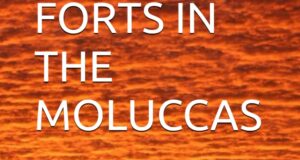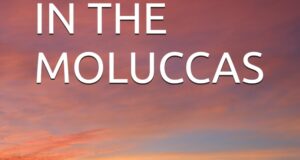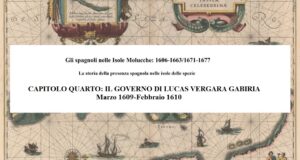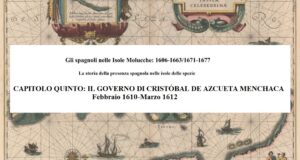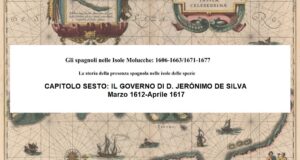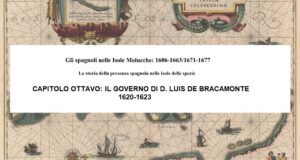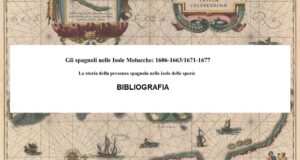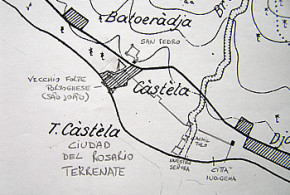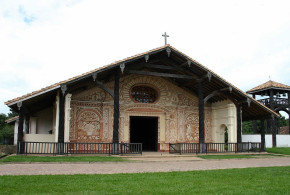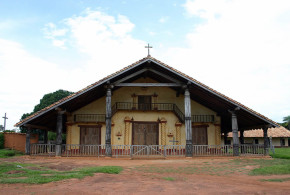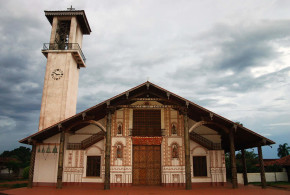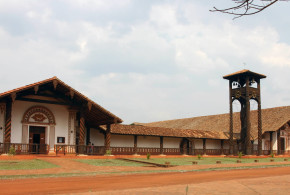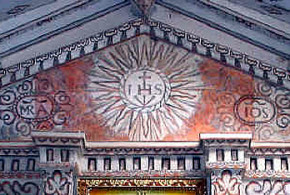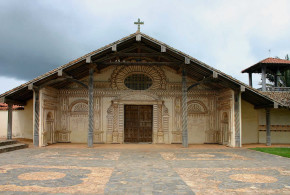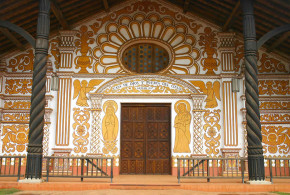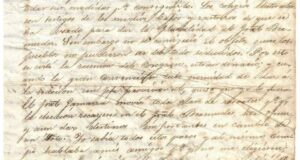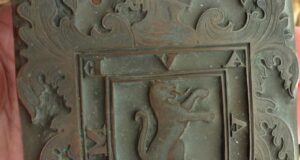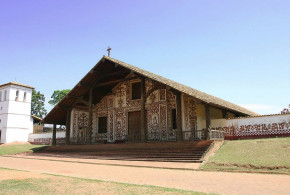This post is also available in:
![]() Italiano
Italiano
Written by Marco Ramerini 2000-2007/2023
6.2 – MARIECO EL CHICO OR TOMANIRA
Spanish: Marieco el Chico:
Dutch: Kleine Marieko, Spaens Mariecque.
This fort was built by Geronimo de Silva in 1613, after the loss of Marieco (Marieco el Grande), and was located half a league from Marieco. After the conquest of Marieco by the Dutch, Geronimo de Silva describes in two letters, one to Don Juan de Silva and the other to King Felipe III, the countermeasures he took to defend Tidore from the Dutch, one of them being the fortification of Marieco el Chico: “Piensa lo primero embestir á Marieco el Chico, donde le tengo fortificado lo mejor que se ha podido y puesto allí un capitan con 50 infantes, sin los soldados que el rey y principe han inviado suyos, y algunos naturales”1, “….he fortificado lo mejor que se ha podido otro lugar media legua de este, donde tengo puesto un capitan con cincuenta españoles”2, the captain of Marieco el Chico mentioned by de Silva is Don Juan de Espinosa, he is captain of this garrison in 1613.3 On February 14, 1613, the Dutch to disturb the fortification work of the Spanish in Marieco (Marieco el Chico), bombarded the place, with two ships, from morning until noon ‘… y le metieron dentro mas de setenta balas, …’.4
According to the information gathered, Marieco el Chico and Tomanira were the same fort, called in two different ways. The use of the name Marieco el Chico is made in Spanish documents only for a short period of time mainly during 1613.
Spanish: Tomanira 5, Tomanyira, Tomañira, Tomarina, Tamarina, Tomanera 6, Tamañira: (Current name: ?)
CHRONOLOGY: Spanish: 1613-1621/22 ?; 1657 ?-1662 ?
Tomanira, as we have already mentioned above, was most likely the same fort as Marieco el Chico. According to the documentation collected, the most plausible explanation regarding the position of this fortress is that Tomañira was located on a hill south of Marieco.
The study of the documents has shown that Tomanira must have been located in the western or north-western part of the island, the only one from which the port of Malayo in nearby Ternate is visible. In fact, a letter from Gerónimo de Silva dated 17 April 1616, which describes the arrival of some Dutch ships in the port of Malayo, indicates that they were seen by Tomanira, already at anchor in the port of Malayo. So from Tomanira Malayo was visible.7
Other documents lead us to define more accurately the area of the island where this fortress must have been located. Tomanira is described by Gerónimo de Silva as a port in the vicinity of Marieco el Grande, from where the Dutch had twice attacked it. The garrison of Tomanira in 1614 was formed by a company of Spanish soldiers commanded by Don Diego Quinones: ‘Tambien desde Marieco el Grande va el nemico á el puerto de Tomanira por momentos á tocarles arma, y aun le ha querido embestir por dos veces.’ ‘…está en él el capitan don Diego de Quiñones con su compagnia.’8 D. Diego de Quiñones y Arguelles himself, first captain of the fort of San Pedro y San Pablo in Ternate, and then captain of the ‘fuerça‘ of Tomañira in Tidore in one of his statements indicates that Tomañira was ‘frontera de Marieco’.9 In another document, the fortress of Tomanira in Tidore is defined as a fortress close to that of the Dutch of Marieco ‘las fuerzas de Tomanira ysla de Tidore serca alas del enemigo olandez de Marieco’ ‘la fuerza de Tomanira frente de las de Marieco’.10
Probably, the solution, to the fact that Tomanira and Marieco el Chico are the same fort, is given to us in the “Correspondencia“, in fact Gerónimo de Silva wrote a letter on June 26, 1613 to don Juan de Espinosa (i.e. don Juan de Espinosa y Zayas), in whose charge was the fort of Marieco el Chico, a few days after July 10, 1613, da Silva himself wrote another letter to don Juan de Zayas (i.e. don Juan de Espinosa y Zayas himself) this time quoting Tomanira as the place where he resided.
This closeness of date between the letters, the fact that nothing in the letters seems to indicate a change of assignment of don Juan de Espinosa y Zayas in the meantime, makes me suppose that Marieco el Chico and Tomañira are two different names by which the same fort was called.11 As further confirmation of what has been said, there is another document dated May 24, 1613 drawn up ‘en la ffuerça de Tomanira y ysla de Tidore‘ of which Juan de Espinosa y Zayas signs himself as captain.12
To resolve the doubt about where Tomanira was located, other documents help us, for example Captain Francisco Ximénes who was head of the forts of Rum and Tomanira, informs us that the two fortresses were ‘unas y otras proximas ala que el enemigo tenia en la ysla de Tidore en el lugar de Marieco’.13
Another document informs us that Tomanira was located at a distance of ‘media legua‘ from the Dutch fort (of Marieco). Since the two forts were located so close, they witnessed several clashes between Spanish and Dutch troops. The testimony of Agustín Pérez tells us about one of these clashes. He in 1613 was with his company, that of the captain don Juan de Espinosa y Zayas, in garrison of the fortress of Tomanira on the island of Tidore. From Tomanira, Pérez was sent by Zayas under the command of ensign Anton Castellanos to Marieco where the Spanish had a brief skirmish against some Dutch who were surprised within sight of the Dutch fort, some enemy soldiers were killed in the action. Immediately, from the fort of Marieco the Dutch sent troops into the countryside to help their soldiers, these troops clashed against the Spanish squad and in the clash there were several deaths on both sides.
On another occasion, Pérez was sent by Zayas to Marieco to recognize and spy on the construction of a ‘baluarte‘ that the enemy was fortifying, making a report of what the enemy was building and bringing some ‘herramienta‘ that the enemy used to make the fortification.
Following the report on the work that the Dutch were doing in Marieco, Pérez was sent, again from Tomanira, by Captain don Juan de Espinosa y Zayas back to the enemy fort of Marieco where with three other soldiers and with great danger of their lives (in fact during the retreat, the Dutch from the fort fired many artillery and musket shots against the Spanish) a warehouse and some houses were burned with a fire bomb, which were located at the foot of a bastion inside an ‘estacada‘ where ‘peltrechos y gastadores‘ had been collected. 14
The fort of Tomarina was built on a high hill ‘por estar situada em hum alto‘ difficult to conquer, 40 Spaniards resided in the fort and there were more than 300 men ‘todos naturaes da terra‘ armed with muskets. The fort was equipped with only three pieces of artillery, the scarcity of artillery pieces in the garrisons of the Moluccas is an often recurring note. Also there were many other warriors ‘gente de espada‘ who helped the Spaniards in case of war. Probably part of the population of the village of Marieco, who remained loyal to the king of Tidore, had moved to this fortification.15
Fr. Manuel Ribeiro also makes a brief mention of Tomañira: ‘….Tidore, Don Gil y Tomañira, que son las 3 fuerças que tenemos sobre los tres canales, por donde ordinario las naos enemigas entran y salen, sin que asta agora se les pudiese acer daño’16 Indeed the three channels mentioned above are the channel between Tidore and Halmahera controlled by the fort of Tidore, the channel between Ternate and Maitara controlled by the fort of Don Gil and finally the channel between Tidore and Maitara controlled, in a rather precarious way, by the fort of Tomañira, in fact the Rume fort which will control the canal in a safer way, will be built by the Spaniards only in November 1618.
Also for the description of this fort, the interesting sketch of the west coast of Tidore comes to our aid, preserved in the university library of Leiden and belonging to the “Bodel Nÿenhuis” collection. It was drawn by an anonymous Dutch soldier or sailor and is perhaps the the only fairly detailed representation that has come down to us of Tomanira (the fort is called ‘Spaens Mariecque‘ in the sketch), in it the Spanish fort is represented high on a hill overlooking the sea, it is characterized by two bastions, the fortification seems to be totally of stone.
No structure is drawn inside the fortress. The Spanish flag stands on the highest part of the fortification (this is the characteristic flag with the Burgundy cross, used by Spanish infantry troops in the 16th-17th centuries). Further down on the north side of the Spanish fortification, to be understood on the side where the ramparts are, there is an indigenous village characterized by two groups of houses as well as by a tall minaret-shaped structure which is surmounted by a crescent on the cusp, probably the village mosque. The indigenous village is surrounded by a wall that appears to be of bricks. Both the Spanish fort and the indigenous village are located along the buttresses of a high mountain. The caption above the fort shows the words ‘Spaens Mariecque‘ i.e. Spanish Marieco.17
Spanish documents report the existence of Tomanira in the years between 1613 and c.1620, probably with the abandonment of the fort of Marieco by the Dutch, and the subsequent Spanish occupation of the place, the Spaniards withdrew the garrison from Tomanira.
Tomanira, during the Dutch occupation of Marieco, was, after the fortress of Santiago de los Caballeros, the most important fortification that the Spanish had on the island of Tidore, because being on the border with the Dutch, it had the function of controlling and contrasting the enemy troops who garrisoned Marieco. From Tomanira as we have seen the raids that the Spanish troops carried out against the territories controlled by the Dutch started. Generally a company of Spanish infantry commanded by a captain was present in the fort.
Tomanira is mentioned again in some subsequent documents, where the rebellion (1657-1658) of some Tidorese villages (Toluca and Tongoiza) is narrated. On the death of Cachil Sayde, these villages elected cachil Golofino as his successor, deposing the legitimate heir to the kingdom of Tidore who was cachil Mole, son of cachil Sayde.18
In the documents that speak of this rebellion, Tomanira is also mentioned. Here the Spaniards had a garrison at that time headed by adjutant Francisco Peres.19 Another document from that period mentions Tomanira, where Admiral Juan de Aytamarren was with Nicolas de Aybar at ‘talar las puertas y sembrados de Marrico y Tomanira’ (‘to cut down doors and crops’). Tomanira, was situated on a narrow pass (‘por estar desembocada y sobre abizo’) and the enemies had been warned of the action of the Spaniards. In the ensuing battle, Captain Manuel de Billa Sola (Villasola?), who commanded the vanguard of the Spanish troops. The other troops, however, managed to react and push back the enemies who then fled, leaving the countryside in Spanish hands.20
Subsequently the Spaniards must have maintained garrisons in the area of Tomanira and Toloa, in fact in 1662, some documents describing the abandonment of some forts in Tidore also speak of the abandonment of some forts close to the villages of the ‘Mori’ of Toloa: ‘que asistiese y aiudase a su capitan al rretirar las fuerzas de Tidore, con las de Chobo y otras circumbecinas a los pueblos de los Moros toloas’.21
| Captains of Tomanira | |
| Juan de Espinosa y Zayas22, captain | 1613 |
| Diego de Quiñones y Arguelles23, captain | 1614 |
| Hernando (Fernando) Suárez24 | Between the years 1614 and 1618 |
| Gregorio Lopes25, captain | ? |
| Pedro de la Fuente Urres (Urrez)26 | |
| Pedro de Saavedra27, captain | ? |
| Pedro de la Fuente Urres (Urrez) 28, captain | ? |
| Alonso Martín Quirante29, captain | 1617-1618 |
| Pedro de la Fuente Urres (Urrez) 30 | ? |
| Rodrigo de Moscoso y Sotomayor31, captain | ? |
| Pedro de la Fuente Urres (Urrez) 32 | 1618 |
| Pedro Martinez Cid33, captain | 1618 ? |
| Juan de la Umbria34, captain | ? |
| Juan de Chaves35, captain | 1619 ? |
| Antonio Maldonado y Moscosso (Moscoso)36 | ? |
| Francisco Ximenes37, captain | |
| Julio de Helguera38, captain | 1621/22 ? |
INDEX:
1 – The Spanish fortresses on the island of Tidore 1521-1663: introduction
3 – The Spanish expeditions to the Moluccas after the union with Portugal
4 – The Spanish forts of the island of Tidore 1606-1663
5 – The defenses of the city of the King of Tidore: Lugar Grande De El Rey (Soa Siu)
6 – Fuerte de los portugueses (Fortaleza dos Reis Magos)
7 – Tohula Fort, Santiago de los Caballeros
8 – Sokanora Fort
9 – Marieco Fort
10 – Tomanira Fort
11 – Chobo Fort
12 – Fort of Rume
13 – Puli Caballo Island
14 – Captains of Tidore (Fortress of Santiago de los Caballeros)
NOTES:
1 “Carta que escribió el señor don Gerónimo de Silva al señor don Juan de Silva” in: Various authors “Correspondencia” 99
2 “Carta dirijida á S. M. por don Gerónimo de Silva, Terrenate” in: AA. VV. “Correspondencia” 122
3 “Carta que el gobernador don Gerónimo de Silva escribió á el capitan don Juan de Espinosa, ã cuyo cargo estã Marieco el Chico, en 26 junio de 1613” in: Various authors “Correspondencia” 133
4 “Carta que escribió el señor don Gerónimo de Silva al señor don Juan de Silva” in: Various authors “Correspondencia” 102
5 Various authors “Correspondencia” 226, 329, 358, 388, 397
Rios Coronel, Hernando de los “Memorial y relacion…” 1621, Madrid, Spain. In: Blair, E. H. e Robertson, J. A. “The Philippine Islands, 1493-1898” vol. 19 (1620-1621), 214, where an extract from Jeronimo de Silva’s letter to D. Juan de Silva, dated July 29, 1616, is reported.
6 Various authors “Correspondencia” 309
7 “Tanto de carta que el gobernador don Gerónimo de Silva escribió á el señor don Juan de Silva capitan general, en 17 abril de 1616. Esta carta llevó una caracoa de rey de Tidore” In: Various authors “Correspondencia” 358
8 “Tanto de carta que el señor don Gerónimo de Silva escribió á el señor don Juan de Silva con Zapata, 3 jullio de 1614” In: Various authors “Correspondencia” 226
9 Colin-Pastells “Labor Evangelica” vol. III, 571 nota n°1
10 “Confirmación de encomienda de Guisan, etc. Expediente de confirmación de las encomiendas de Guisan, Lantac, Adpili, Panglao, Masago, Panaon y Ormoc en Cebu en Leyte a Juan de Medina Bermudez. Resuelto, [f] 12-08-1633” AGI: Filipinas,48,N.67
11 “Carta que el gobernador don Gerónimo de Silva escribió á el capitan don Juan de Espinosa, ã cuyo cargo estã Marieco el Chico, en 26 junio de 1613” in: AA. VV. “Correspondencia” 133
“Tanto de carta que escribió á el capitan don Juan de Zayas en Tomanira á 10 de jullio de 1613 el gobernador don Gerónimo de Silva”in: Various authors “Correspondencia” 141-142
12 “Confirmación de encomienda de Canaman, etc. Expediente de confirmación de las encomiendas de Canaman, Milavit, Camalingan, Bagtas y Daet en Camarines a Pedro Martínez Cid. Resuelto, [f] 23-12-1624” AGI: Filipinas,47,N.72
13 “Confirmación de encomienda de Tulaque, etc Expediente de confirmación de las encomiendas de Tulaque, Mandayat y Buguey en Cagayan a Pedro de Mora. Resuelto, [f] 13-05-1639” AGI: Filipinas,49,N.31
14 “Confirmación de encomienda de Maquila, etc. Expediente de confirmación de las encomiendas de Maquila y Tulaque en Cagayan a Agustín Pérez. Resuelto. [f] 21-10-1633” AGI: Filipinas,48,N.76
“Confirmación de encomienda de Filipinas.Expediente de confirmación de encomienda en el distrito de la Audiencia de Filipinas a Agustín Pérez. Resuelto. [f] 11-01-1638” AGI: Filipinas,49,N.18
15 “Relação breve da ilha de Ternate, Tydore…., Malaca, 28 novembre 1619” in: Various authors “Doc. Ultramarina Portuguesa” vol. I, 167
16 “Lettera di Fr. Manuel Ribeiro al governatore Fajardo, Cavite, 10 agosto 1618” in: Jacobs, H. “Documenta Malucensia III, 1606-1682” Doc. n° 106, 377
17 “Tidor en Mitarra, 2 kleine eil. Ten Z. van Ternate, ten W. van Gilolo op Halmahera” University Library of Leiden, the Netherlands: “Collectie Bodel Nÿenhuis” P. 314-I-n° 99
My thanks to Walter Hellebrand for alerting me to the existence of this important document.
18 “Confirmación de encomienda de Mambusao. Expediente de confirmación de la encomienda de Mambusao en Panay a Sebastián de Villarreal. Resuelto. [f] 19-05-1676” AGI: Filipinas,54,N.11
19 “Confirmación de encomienda de Baratao. Expediente de confirmación de las encomiendas de Baratao en Pangasinan a Alonso Lozano. Resuelto. [f] 16-06-1676” AGI: Filipinas,54,N.12
20 “Confirmación de encomienda de Abucay, etc. Expediente de confirmación de las encomiendas de Abucay y Samal en Pampanga a Diego Cortés. Resuelto. [f] 12-05-1676” AGI: Filipinas,54,N.9
21 “Confirmación de encomienda de Majayjay, etc. Expediente de confirmacion de las encomiendas de Majayjay y Santa Cruz en La Laguna de Bay a Juan Rodríguez de Origuey. Resuelto[f]. 08-06-1695” AGI: Filipinas,58,N.3
Memorial of the ensign Juan de Origuey (Manila, 20 September 1673) (sheets 18-20) in: “Confirmación de encomienda de Batangas. Expediente de confirmación de la encomienda de Batangas en Balayan a Lorenzo de Zuleta. Resuelto. [f] 03-04-1677” AGI: Filipinas,54,N.14
22 It appears to be captain of the fortress of Tomanira in a written document dated May 24, 1613 ‘en la ffuerça de Tomanira y ysla de Tidore’. “Confirmación de encomienda de Canaman, etc. Expediente de confirmación de las encomiendas de Canaman, Milavit, Camalingan, Bagtas y Daet en Camarines a Pedro Martínez Cid. Resuelto, [f] 23-12-1624” AGI: Filipinas,47,N.72
E’ ancora capitano del forte di Tomanira nel luglio 1613 “Tanto de carta que escribió á el capitan don Juan de Zayas en Tomanira á 10 de jullio de 1613 el gobernador don Gerónimo de Silva”in: Various authors “Correspondencia” 141-142
23 In July 1614 the captain don Diego de Quiñones with his company was in garrison of the fort of Tomanira. “Tanto de carta que el señor don Gerónimo de Silva escribió á el señor don Juan de Silva con Zapata, 3 jullio de 1614” In: Various authors “Correspondencia” 226
24 The testimony of Juan de la Umbria dated November 30, 1618, mentions that Hernando (Fernando) Suárez was chief of the forts of Tomanira, San Pedro y Sant Pablo, Tafongo y Payaxe, without however indicating in which period. “Confirmación de encomienda de Masbate. Expediente de confirmación de la encomienda de la isla de Masbate en Ibalon (Albay) a Fernando [Hernando] Suárez. Resuelto, [f] 22-11-1623” AGI: Filipinas,47,N.65
25 “Informaciones: Pedro de la Fuente Urroz. Informaciones de oficio y parte: Pedro de la Fuente Urroz, capitán, vecino de Manila. Informaciones y poder. [f] 1632” AGI: Filipinas,61,N.12
26 Pedro de la Fuente Urroz, was appointed by the governor Don Geronimo de Silva head of the fortress of Tomanira, a fort close to the Dutch one, 4 times in deferent times. The first time he succeeded Captain Gregorio Lopes, the second time he replaced Captain Pedro de Saavedra, the third time he replaced Captain and Major Sergeant Alonso Martin Quirante, the fourth and last time he replaced Captain Don Rodrigo de Moscoso. Four times in different periods he commanded this fort.
“Informaciones: Pedro de la Fuente Urroz. Informaciones de oficio y parte: Pedro de la Fuente Urroz, capitán, vecino de Manila. Informaciones y poder. [f] 1632” AGI: Filipinas,61,N.12
“Confirmación de encomienda de Agoo. Expediente de confirmación de la encomienda de Agoo en Pangasinan a Pedro de la Fuente Uriez (sic por Urroz). Resuelto. [f] 28-09-1630” AGI: Filipinas,48,N.39
27 “Informaciones: Pedro de la Fuente Urroz. Informaciones de oficio y parte: Pedro de la Fuente Urroz, capitán, vecino de Manila. Informaciones y poder. [f] 1632” AGI: Filipinas,61,N.12
“Informaciones: Pedro de la Fuente Urroz. Informaciones de oficio y parte: Pedro de la Fuente Urroz, capitán, vecino de Manila. Informaciones y poder. [f] 1632” AGI: Filipinas,61,N.12
“Confirmación de encomienda de Agoo. Expediente de confirmación de la encomienda de Agoo en Pangasinan a Pedro de la Fuente Uriez (sic por Urroz). Resuelto. [f] 28-09-1630” AGI: Filipinas,48,N.39
29 In 1617, Captain Alonso Martín Quirante was castellan of the fortress of Tamarina. Pérez, Lorenzo O.F.M. “Historia de las misiones de los Franciscanos en las islas Malucas y Célebes” In: “Archivum Franciscanum Historicum” VII (1914) 429.
Another document indirectly informs us that Alonso Martin Quirante was still in charge of Tomanira in 1618, in fact, Juan de Medina Bermudez, was a soldier of the company of Alonso Martin Quirante in charge of the fortress of Tomanira in Tidore, close to that of the Dutch of Marieco (‘las fuerzas de Tomanira ysla de Tidore serca alas del enemigo olandez de Marieco’)(‘la fuerza de Tomanira frente de las de Marieco‘), here he had a hard fight against the Dutch where many enemies were killed and where Juan de Medina was wounded by a musket shot in the left shoulder. On April 18, 1618, Medina had license by Lucas Vergara Gaviria to come to Manila, to recover from a wound in his left arm. “Confirmación de encomienda de Guisan, etc. Expediente de confirmación de las encomiendas de Guisan, Lantac, Adpili, Panglao, Masago, Panaon y Ormoc en Cebu en Leyte a Juan de Medina Bermudez. Resuelto, [f] 12-08-1633” AGI: Filipinas,48,N.67
According to another document, he was succeeded by Pedro de la Fuente Urroz. “Informaciones: Pedro de la Fuente Urroz. Informaciones de oficio y parte: Pedro de la Fuente Urroz, capitán, vecino de Manila. Informaciones y poder. [f] 1632” AGI: Filipinas,61,N.12
30 Pedro de la Fuente Urres (Urrez) was in 1616 head of the fortress of Tomanira, he commanded the company of Captain don Rrodrigo de Moscosso y Sotomayor. He commanded this fort four times in different periods. “Confirmación de encomienda de Agoo. Pedro de la Fuente Uriez (Uroz). 28-09-1630” AGI: Filipinas,48,N.39
31 “Informaciones: Pedro de la Fuente Urroz. Informaciones de oficio y parte: Pedro de la Fuente Urroz, capitán, vecino de Manila. Informaciones y poder. [f] 1632” AGI: Filipinas,61,N.12
32 In 1618, Captain Pedro de la Fuente Urres (Urrez), by order of Lucas de Vergara Gaviria, was again appointed head of the fortress of Tomanira. “Informaciones: Pedro de la Fuente, 1632” AGI: Filipinas, 61, N.12
33 Pedro Martinez Cid, in 1617 had the force of Jilolo at his charge. He then became head of the fortress of Tomanira. Subsequently he was then appointed head of the fortress of Tidore, a position he held for a year and a half maintaining order and good relations with the citizens and the king of Tidore. On February 19, 1620 he ceased his service as captain at Ternate, he must have departed for Manila shortly after due to ill health. “Confirmación de encomienda de Canaman, etc. Expediente de confirmación de las encomiendas de Canaman, Milavit, Camalingan, Bagtas y Daet en Camarines a Pedro Martínez Cid. Resuelto, [f] 23-12-1624” AGI: Filipinas,47,N.72
34 Juan de la Umbria, in December 1616 was sent by the Audiencia, to Ternate, for the occasion he was appointed captain of an infantry company and head of the “socorro” sent to warn Gerónimo de Silva of Juan de Silva’s death. He remained in Ternate at the head of an infantry company. During this period he served as captain of the presidios of Tidore, Tomanira, Xilolo, San Pedro y San Pablo. During the absence of the governor Vergara (who often resided in Tidore), Juan de la Umbria took his place in the city of Ternate. In May 1618 he was chief of the forts of Tidore. “Confirmación de encomienda de Guisan, etc. Expediente de confirmación de las encomiendas de Guisan, Lantac, Adpili, Panglao, Masago, Panaon y Ormoc en Cebu en Leyte a Juan de Medina Bermudez. Resuelto, [f] 12-08-1633” AGI: Filipinas,48,N.67
35 Juan de Chaves, was in charge of the forts of Xilolo, Marieco and Tidore (these before April 1623). Juan de Chaves, Bracamonte tells us, always had a good relationship with the king and prince of Tidore. He probably served in 1619 as the head of the Tomanira fort. He had already been made captain by Lucas de Vergara Gaviria, on June 27, 1617, and governed his own company until he was succeeded by Master Sergeant Pedro de Cuenca Montalbo, then later Juan de Chaves returned to command his company where he served for more than 5 years. In these five years he was in charge of the forts of San Pedro y San Pablo and Santa Lucia, Xilolo (Hilolo), Tomanira (Tomanera), Marieco (Merieco) and Tidore (‘Santiago de los Caualleros en la ysla de Tidore‘) as well as that due to the absence of the governor he had the city of Ternate in his charge. “Confirmación de encomienda de Caraga. Expediente de confirmación de la encomienda de Caraga a Juan de Chaves. Resuelto, [f] 14-02-1631” AGI: Filipinas,48,N.49
36 Antonio Maldonado y Moscoso, was chief of the fort of ‘San Xpoual’ in the kingdom of Jilolo, of the ‘fuerte y fuerza‘ of Tomanira in the kingdom of Tidore, and of the fort of San Pedro y San Pablo which he fortified, by order of the governor Lucas de Vergaria Gaviria. He was head of the ‘fuerte y fortaleza’ del Principe di Tidore. “Confirmación de encomienda de Paracale, etc. Expediente de confirmación de las encomiendas de Paracale y Capalonga en Camarines a Antonio Maldonado y Moscoso. Resuelto, [f] 05-07-1659” AGI: Filipinas,51,N.3
37 He arrived in Ternate around 1620 and replaced Captain Pedro Martinez Cid in command of his company. He was chief of the forts of Rum and Tomanira ‘unas y otras proximas ala que el enemigo tenia en la ysla de Tidore en el lugar de Marieco’.“Confirmación de encomienda de Tulaque, etc Expediente de confirmación de las encomiendas de Tulaque, Mandayat y Buguey en Cagayan a Pedro de Mora. Resuelto, [f] 13-05-1639” AGI: Filipinas,49,N.31; “Confirmación de encomienda de Tulaque, etc Expediente de confirmación de las encomiendas de Tulaque, Mandayat y Buguey en Cagayan a Pedro de Mora. Resuelto, [f] 13-05-1639” AGI: Filipinas,49,N.31
38 Julio de Helguera, was captain of the fort of Tomanira (Somamra in the transcription), a fortress located ‘a tiro de cañón‘ from the Dutch fort of Marieco (Amarisco in the transcription). Gonzalo Portillo was serving as squad leader of Captain Julio de Helguera’s company which was stationed at Tomanira and was sent to Marieco to see if the Dutch actually intended to dismantle that fort. A precise date is not indicated in the document, but the episode should refer approximately to the years around 1620, i.e. when the Dutch actually abandoned Marieco. “Nombramiento e instrucciones de Sebastián Hurtado de Corcuera a Gonzalo Portillo, nuevo gobernador de la Isla Hermosa, en nombre del Rey Felipe IV. Se mencionan sus meritos e historia militar. Manila, 13 de abril de 1640” AGI: Escribania 409B f. 153 published in: : Borao J. E. “Spaniards in Taiwan” vol. I, 310
This post is also available in:
![]() Italiano
Italiano
 Colonial Voyage The website dedicated to the Colonial History
Colonial Voyage The website dedicated to the Colonial History


